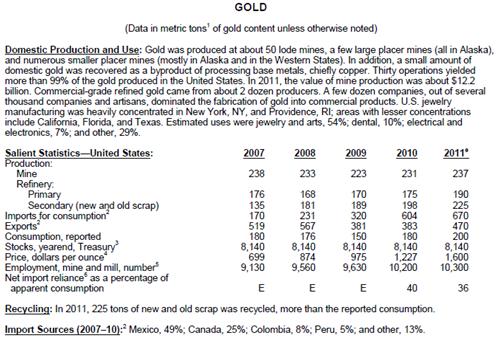Want to know how much gold the U.S. produced in 2011? Or how many copper reserves Chile has? Or why global demand for silver in X-ray films is declining?
All that information is easy to find. And the best part is – it’s free.
The U.S. Geological Survey put out an annual “Mineral Commodity Summaries” guide. The guide contains information on events, trends and issues for more than 90 different mineral commodities.
World production and resources, 5-year salient statistics, government programs and domestic industry structure are among the data the guide covers.
Put simply, the Mineral Commodity Summaries is THE guide every commodity investor should keep handy. (And NO, the U.S. Geological Survey is not paying me to write this.)
Say you’re considering investing in gold stocks, for instance.
The “Mineral Commodity” guide tells you that 30 mining operations yielded 99% of the gold produced in the United States in 2011. Right there, that tells you – if you’re looking for a U.S. gold producer to invest in, it should probably be one of those 30 companies.
Here’s a screen grab of the “gold” entry:
Or say you’re a silver investor in search of a cheap overseas silver-mining stock.
The guide lists the total reserves and previous years’ mine production in some of the top silver-producing countries in the world. For instance, through 2011, Peru boasted the most silver reserves on the planet, holding more than a fifth of the world’s total reserves.
Or, if you’re looking for trends, Mexico was the top silver producing country in the world each of the past two years.
Want to take a broader look at the overall role minerals play in the U.S. economy? The guide has that too.
This year’s edition tells you that the value added to the U.S. economy by major industries that consume processed mineral materials in 2011 was $2.23 billion – almost 15% of our $15.1 billion gross domestic product last year.
Also, according to the guide, U.S. mineral production increased for a second straight year in 2011. It says:
“The estimated value of U.S. metal mine production in 2011 was $37.1 billion, about 23% more than that of 2010. Principal contributors to the total value of metal mine production in 2011 were gold (30%), copper (27%), iron ore (16%), molybdenum (10%), and zinc (5%).”
Or how about this nugget, which sheds some light on the progress of the housing turnaround:
“The construction industry began to show signs of improvement during 2011, with increased production and consumption of cement, construction sand and gravel, and gypsum—mineral commodities that are used almost exclusively in construction.”
That’s helpful whether you’re a commodity investor or a real estate investor.
Literally and figuratively, much of the information in the “Mineral Commodity Summaries” is pure gold.
Good investing,
Chris Preston
 Facebook
Facebook
 Twitter
Twitter
